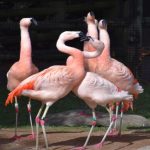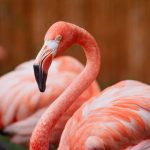Flamingos obtain their pink color from a naturally occurring chemical in the food they ingest. Algae and crustaceans are part of their diet, and the same chemical may also be found in carrots and pumpkins. The diet of flamingo, which is rich in alpha and beta carotenoid pigments, colors its feathers, legs, and face.
Flamingos ingest algae and crustaceans that contain carotenoids, which are hues. These pigments are largely prevalent in the brine shrimp and blue-green algae that the birds ingest. Flamingos’ feathers, beaks, and legs have lipids (fats) that make them look pink and orange.
Enzymes in the liver break down carotenoids into molecules of pink and orange pigment, which are absorbed by lipids in their feathers. Because of a deficiency in carotenoids in its diet, fresh feather production will be very pale, and the present color will be lost via molting as a result.
A study found that flamingos that mostly devour algae are more vibrantly colored than birds that primarily ingest algae-eating small invertebrates. There are flamingos in the Caribbean that are bright pink and orange. There are also flamingos in Kenya that are a delicate pink.
Otherwise, captive flamingos would be white or light pink since they are fed a special diet that incorporates prawns (a pigmented crustacean) or chemicals such as beta-carotene or canthaxanthin, which give them their bright colors. It is grey in color when young flamingos are first born and changes color based on what they eat.

Are Flamingos Pink Because They Eat Salmon?
No. Flamingos are filter feeders, consuming algae and small invertebrates such as shrimp, mollusks, and insect larvae that are found in the muck at the bottom of shallow ponds. Flamingos are members of the duck family.
The pigments in the organisms that flamingos ingest are responsible for the beautiful rose-pink color of their feathers. Both salmon farmers and zookeepers employ carotenoid supplements, such as canthaxanthin or a related pigment, to keep their fish and flamingos looking bright and healthy.
Both in the wild and in captivity, this pigment is responsible for replicating the coloration prevalent in wild animals. Flamingos kept in zoos need a high-carotene diet in order to maintain their distinctive plumage.
Flamingos may be fed shrimp and clams because carotenoids are present in mollusks and crustaceans, which are good sources of vitamin A. Spoonbills and pink ibises are similarly brightly colored as a result of the carotenoids they consume.

Do Flamingos Turn Pink By Eating Shrimp?
Yes, Flamingos get their pink color by eating shrimp and other foods like blue-green algae and mollusks. This occurs because shrimp contain the pigment beta-carotene, which is responsible for the color shift. When juvenile grey-and-white flamingos eat brine shrimp and other food sources, their skin becomes pink.
Shrimps are abundant and readily available in marshes, making them an ideal food source for flamingos. Shrimps are plentiful because they are harmful to other predators. As a result, they are the only food source available to flamingos.
Many people assume that flamingos prefer shrimp as a food source since they usually devour these little invertebrates. As a result, shrimp get the greatest credit for the color shift. The shrimp are eaten by the flamingos by stirring up the dirt at the lake’s bottom, where shrimp generally hide.
The birds reach down and strain the shrimps out of the muck with a beak full of water and mud. The rest of the muddy water is thrown away.

Why Do Flamingos Eat Upside Down?
First of all, this is not accurate. Flamingos do not eat upside down. It’s just their bills that they hold backwards. It’s crucial to acknowledge that flamingos are filter feeders. This implies that they drink a lot of water and then filter their food out of it.
Lamellae are structures found in flamingos that assist them in filtering food and draining water and muck. The bristle-like structures on the powerful tongue push and draw water out and in.
The flamingo’s beak is kept upside down in the water to let it take in more water and food and then readily discharge any excess water or food that is too big or too small for it.

What Does Baby Flamingo Eat?
Flamingo chicks, like other newborn birds, are tiny and grey or white in color. During the first several weeks, they are fully dependent on their parents for feeding. In their bodies, flamingo parents create a kind of “crop milk.” This milk is created particularly for the chicks and is brilliant red in color, like blood.
This milk is high in proteins and lipids, both of which are essential for rapid development. Flamingos drink this milk, which gives them a bright pink tint that darkens with time. The young flamingos are ready to leave their nest after a few weeks and begin eating with the group as adults.

Also read our article on what flamingos eat and drink.
What is The True Color of a Flamingo?
Flamingos acquire their name from the Portuguese/Spanish phrase ‘flamengo,’ which means ‘flame-colored,’ referring to their bright feathers; nevertheless, they are not born pink. In contrast, Flamingo chicks, on the other hand, have a dull grey color to their feathers when they hatch.
In Cyprus, though, an incredible black flamingo was sighted. It is believed that it suffered from a disease that changed the color of its feathers.
The Greater Flamingo is the tallest flamingo species. Their feathers are paler, and their bills are pink rather than other flocks. The smallest and most frequent flamingo is the lesser flamingo. They are most often common in Africa but have been seen as far away as Spain and Afghanistan.

Do Yellow Flamingos Exist?
The carotenoid pigments in a flamingo’s diet are responsible for the color of the bird’s feathers and beak. Flamingo males and females are both the same color as each other.
A flamingo’s legs and feet have different colors depending on the species, ranging from yellow to orange to pink-red. The Andean flamingo is the only species of flamingo that has yellow legs and feet.
Do Blue Flamingos Exist?
On January 23rd, 2012, blue flamingos (Aenean phoenicopteri) were discovered in the Isla Pinzon archipelago (in the Galapagos Islands). Blue flamingos, unlike their American counterparts, have vivid blue feathers, yellow eyes, and small bodies. “South American Blue Flamingo” is the name given to the bird.
It looked like a regular flamingo, except it was blue and smaller than a typical American flamingo. There was just a tiny flock of birds collected together; compared to the vast number of flamingos you’d see on a beach elsewhere. There are just thirteen South American Blue Flamingos known to live in the world.
The Blue Flamingo from South America is 49 inches tall (from head to heel). Male birds would exhibit their attractive feathers and vocal tones in order to attract the attention of females. Flamingo chicks are born with light blue down that develops into brilliant feathers as they grow bigger.
The South American Blue Flamingo and the American flamingo do not get along, and they yell and peck each other aggressively. The birds are shy at first, but as you get to know them, they become exceedingly sociable and lively. If you approach a blue flamingo that is unfamiliar to you, the bird will almost certainly attempt to peck you.
The eyesight of the South American Blue Flamingos is poor, which makes them a target for predators. As a result, they take advantage of the circumstance and assault the blue flamingo whenever the opportunity arises. Finally, you should avoid approaching a sleeping South American Blue Flamingo.
He or she will most likely wake you up and assault you. Many blue flamingos have incredibly keen hearing and can hear you if you are close enough.
Are Purple Flamingos Real?
No, Purple Flamingos are not real. They are generally grey or white in color and turn pink throughout their first few years of life.
Is Flamingo Poop Pink?
“No, flamingo poop isn’t pink,” Flamingo poop is grayish-brown and white in appearance, much like other bird dung. When flamingo chicks are very young, their excrement may seem a little orange, although this is due to the yolk they ate in the egg being processed. Similar misconceptions say that a flamingo’s egg and yolk are pink as well, but experts have disproved these claims.
Do Flamingos Only Live in Countries where they are Pink?
Flamingos have captivated people with their vibrant pink plumage and graceful presence. However, it is a common misconception that they only inhabit countries where flamingos live. In reality, these elegant birds can be found in various countries around the world, from Africa to Europe, Asia to the Americas. Their distinct coloration is due to their diet, specifically the presence of pigments in certain food sources. Therefore, although synonymous with tropical locales, flamingos can thrive in diverse habitats across the globe.
Do Black Flamingos Exist
Yes, Black Flamingos do exist but it is extremely rare. It was last seen in 2015 at the Mediterranean Island’s Akrotiri Environmental Center. Another sighting of this black flamingo occurred in Israel in 2013. Melanism, a hereditary disease, caused the flamingo to become black instead of pink.
Melanism may result in the production of excessive pigments, which can darken the feathers of any bird. Melanism may be caused by a genetic mutation, but in certain cases, it can also be induced by a certain diet.
Melanism may help the bird fool predators; however, too much pigment can cause the feathers to dry out, become brittle, and become fragile.









